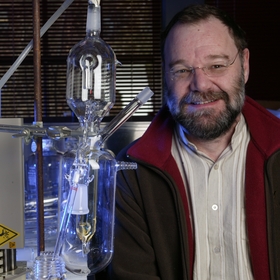

Antony
Dean
Research statement
I study the molecular basis of natural selection. That natural selection targets whole organisms is well known, but discerning its effects from the background stochastic noise characteristic of evolution at the molecular level remains a major goal. The approach I use places a strong emphasis on the relations between protein structure and protein function rather than on the genic analyses that comprise much of the field. The emphasis arises from the need to understand the mechanistic basis of natural selection, as opposed to merely detecting statistical deviations from the expectations of naive neutral genic models. An understanding of these mechanisms requires an understanding of phenotype, and the study of molecular phenotypes is, de facto, the study of biochemistry.
I use two metabolic systems in Escherichia coli as models of molecular evolution: the lactose operon and the isocitrate dehydrogenase. The lactose operon has been used to investigate the relations between enzyme activity and fitness in the intensely competitive environment imposed by continuous nutrient limited growth in chemostats. This work has resulted in a mechanistic kinetic model of natural selection that is capable of predicting the direction and intensity of natural selection from a knowledge of biochemistry alone. The system is being used to investigate the evolution of dominance, pleiotropy, epistasis, gene x environment interactions, ecological specialization and evolutionary stability of a competitive ecosystem.
Phylogenetic reconstruction reveals that the NADP-dependence of bacterial isocitrate dehydrogenases (IDH) evolved around the time the eukaryotes first appeared (3.5 billion years ago) from and NAD-dependent precursor. High resolution X-ray structures of the binary complexes with bound coenzymes of IDH and the distantly related isopropylmalate dehydrogenase (IMDH) have been used to guide site directed mutagenesis, which has proven successful in inverting the coenzyme specificities of both enzymes. Ancestral character states reconstructed using a maximum likelihood algorithm reveal that the engineered NAD-IDH contains the inferred ancestral substitutions while the engineered NADP-IMDH, unique in the history of life on this planet, possesses all the substitutions associated with this ancient adaptive event. Engineering the coenzyme specificities of IDH and IMDH bridges the gap between sequence and phenotype lacking in so many molecular evolution studies, so that sites subjected to natural selection 3.5 billion years ago are identified. This work demonstrates that the adaptive history of molecular evolution is amenable to experimental investigation. This system is now being used to investigate the molecular structure underlying adaptive landscapes and how this influences opportunity and constraint on the adaptive process.
Selected publications
Zhang, L, H Yang, M Long, L Li, AM Dean. 2010. Evolution of enzymatic activities of testis-specific short-chain 9dehydrogenase/reductase in Drosophila. J Mol Evol 71:241-249.
Lunzer, M, GB Golding, AM Dean. 2010. Pervasive cryptic epistatis in molecular evolution. 6(10): e1001162. doi:10.1371/journal.pgen.1001162 PLoS Genetics
Dean, AM. 2010. The future of molecular evolution. 11:409EMBO Reports.
Dykhuizen DE, AM Dean. 2009. Short term experimental evolution: from the bottom up. In: Experimental Evolution: Concepts, Methods, and Applications, pp 65-87. T Garland Jr, MR Rose, Eds. University of California Press, Berkeley, CA.
Stoebel DM, AM Dean, DE Dykhuizen. 2008. The cost of protein expression is in the process, not the product. 1653-1660178:Genetics
Dean AM & JW Thornton. 2007. Evolution and gene function: a new synthesis in molecular biology and evolution. 675-6888:Nat Rev Genet
Merlo LMF, MJ Sadowsky, JA Ferguson & AM Dean. 2006. Selection and polymorphism at the argR locus of Escherichia coli. 376:240-247Gene
Lunzer M, SP Miller, R Felsheim & AM Dean. 2005. The biochemical architecture of an ancient adaptive landscape. 310:499-501Science
Suiter AM, & AM Dean. 2005. Selection in a seasonal environment: the impact of phenotypic lag on Darwinian fitness. 61:153-170J Mol Evol
Dean, AM. 2005. Protecting haploid polymorphisms in temporally variable environments. 169:1147-1156Genetics
Education
Ph.D., Washington University, St. Louis, 1987